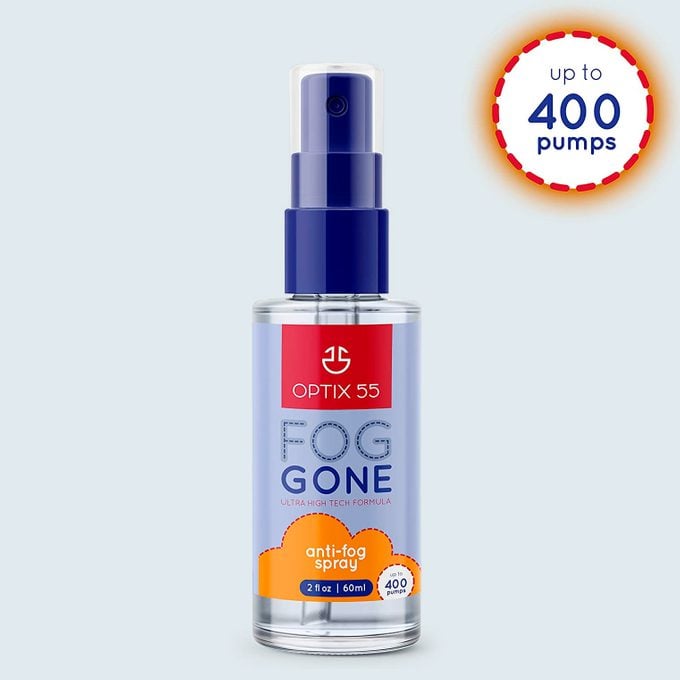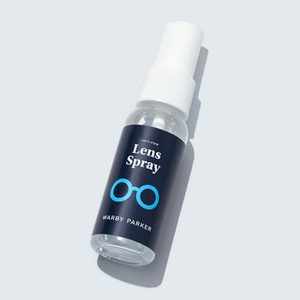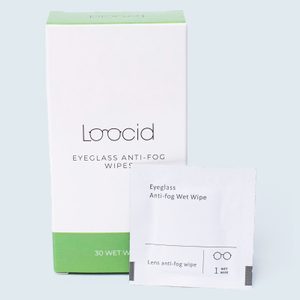The Under $11 Spray That Keeps Your Glasses Fog-Free Over a Face Mask
Updated: Jun. 22, 2022

We've talked to glasses and mask-wearing experts to find out why glasses fog up when wearing a face mask.
If you wear glasses (or sunglasses) and you’ve been staying safe during COVID-19 by wearing a mask, you’ve discovered every glasses-wearing healthcare workers’ biggest annoyance: fogged-up glasses. You’re just trying to breathe like normal and suddenly you can’t see. We’ve talked to glasses and mask-wearing experts to find out why this happens, and they gave tips and tricks on how to stop this from happening to you. Even better, we found an anti-fog spray that helps keep glasses fog-free.
Why do your glasses fog up?
Wearing masks isn’t the only time glasses-wearers have experienced sudden fogged lenses. Drinking a hot beverage, or walking out into a cold winter day is well-known to cause this phenomenon. So why do masks have the same effect?
“As we wear masks, our warm breath will land on the cool lenses of our glasses, this then creates condensation or fog and may prevent you from seeing what you are doing. You may have noticed this also happens when you wear glasses with a scarf in the winter or when you open an oven door,” Aragona Giuseppe, GP and medical advisor at Prescription Doctor, told Reader’s Digest.
Armine Ghalachyan, MD, of My Mask Saves Lives, agrees. “Glasses fog up when wearing a face mask because exhaled warm air from breathing escapes through the top edge of the mask and causes condensation on glasses. This is similar to a window or mirror fogging up when you breathe on them,” Ghalachyan said.
How to stop your glasses from fogging up

So how do you stop your glasses from fogging up while you wear a mask? Spritz the lenses with Optix 55 Fog-Gone Anti-Fog Spray. It works by creating a shield between the glass and your warm breath—and stops the condensation from sticking to the glass.
To use, apply the anti-fog spray for glasses onto both sides of clean lenses. Then, using your fingers rub it in a circular motion on the entire surface. Let sit for about a minute before gently wiping with a dry soft cloth to clear streaks. The two-ounce bottle should last about 400 sprays.
Amazon users love this stuff, and it has over 23,000 ratings. One healthcare worker raves, “At the beginning of this pandemic I decided to get this wonderful product! We are a clinic that continually is dealing with treating COVID patients and swabbing them out in their cars. Myself and our doctor were both so impressed with this product immediately. I referred several other health care coworkers to also buy this product to eliminate fog from our glasses and goggles. They too were impressed by the prompt arrival of this item but what a dream it was to use. The glasses remain crystal clear, with no retouch during the day and no sensitivity to the product.”
Homemade solutions to keep your glasses fog-free
You may have heard of this trick before. It’s a classic because it works so well. Dab a few drops of dish soap on your lenses and use a cloth dipped in warm or hot water to scrub them clean. The soap works just like a fogging spray and provides a clear film over the glass that will keep it from fogging up.
Shaving cream works similarly and some people swear by it, but our editors found that some streaks were visible with certain brands and preferred both the spray and the soap trick. This isn’t all your household staples can do. Here are 42 extraordinary uses for things you have around the house.
Poor-fitting mask
These are all great solutions to the symptoms of the problem, but to address the real reason your glasses are fogging over, you may need to look at the mask itself. “Fogging of glasses is an indication of poor fit of the mask, specifically, along the upper edge. It is essential for the mask to fit tightly at the upper edge of the mask to prevent air from escaping and fogging up glasses,” Dr. Ghalachyan told Reader’s Digest. “A flexible nose piece, similar to the metal strips used in medical masks, could be added to the homemade masks to help create a better fit at the upper edge. The piece should be flexible enough to be shaped around the bridge of the nose and strong enough to hold the shape and keep the mask edge tight against the skin.”
No, you don’t need to get your mask tailored or buy a special fitted product. Dr. Ghalachyan recommended looking around your house for the tools you need. “Plastic-covered flexible ties attached to coffee bags might be the best option. These are usually flat and sufficiently flexible and strong.” A strip of foam, batting, or fleece that’s sewn into the top of your mask may also do the trick.
Sources:
- Aragona Giuseppe, GP and medical advisor at Prescription Doctor
- Armine Ghalachyan, MD, of My Mask Saves Lives




